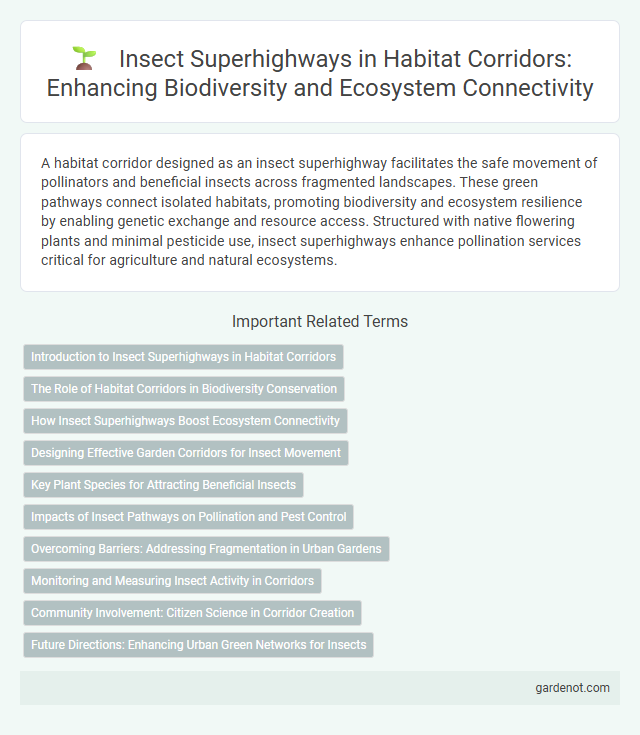A habitat corridor designed as an insect superhighway facilitates the safe movement of pollinators and beneficial insects across fragmented landscapes. These green pathways connect isolated habitats, promoting biodiversity and ecosystem resilience by enabling genetic exchange and resource access. Structured with native flowering plants and minimal pesticide use, insect superhighways enhance pollination services critical for agriculture and natural ecosystems.
Introduction to Insect Superhighways in Habitat Corridors
Insect superhighways within habitat corridors facilitate the movement and dispersal of pollinators, predators, and decomposers essential for ecosystem functioning. These corridors connect fragmented habitats, reducing isolation and enhancing genetic diversity among insect populations. By supporting insect mobility, insect superhighways contribute to pollination services, pest control, and nutrient cycling across landscapes.
The Role of Habitat Corridors in Biodiversity Conservation
Habitat corridors function as insect superhighways, facilitating the movement and genetic exchange of pollinators and other vital insects across fragmented landscapes. These corridors mitigate habitat loss by connecting isolated patches, thereby sustaining biodiversity and ecosystem resilience. Conserving and restoring habitat corridors directly supports pollination services, contributing to the stability of food webs and agricultural productivity.
How Insect Superhighways Boost Ecosystem Connectivity
Insect superhighways enhance habitat corridors by facilitating pollinator movement and genetic exchange between fragmented ecosystems. These pathways improve biodiversity by supporting insect populations critical for plant reproduction and soil health. Strengthened insect connectivity ensures resilient ecosystems capable of adapting to environmental changes.
Designing Effective Garden Corridors for Insect Movement
Designing effective garden corridors for insect movement requires integrating native flowering plants that provide continuous nectar sources and shelter throughout the seasons, promoting diverse insect species such as bees, butterflies, and beetles. Structured layers of vegetation, including ground cover, shrubs, and tall plants, facilitate seamless transit and habitat connectivity across fragmented urban or agricultural landscapes. Incorporating features like undisturbed soil patches and avoiding pesticide use enhances habitat quality, ensuring the corridor functions as a sustainable insect superhighway supporting pollination and ecosystem resilience.
Key Plant Species for Attracting Beneficial Insects
Key plant species such as milkweed, goldenrod, and lavender play a crucial role in establishing insect superhighways by attracting beneficial insects like pollinators and predators. These plants provide essential nectar, pollen, and habitat resources that support insect biodiversity and enhance ecological connectivity within habitat corridors. Incorporating native flowering species boosts the resilience and effectiveness of insect movement corridors, promoting ecosystem health and agricultural productivity.
Impacts of Insect Pathways on Pollination and Pest Control
Insect pathways within habitat corridors significantly enhance pollination by facilitating the movement of key pollinators such as bees, butterflies, and beetles across fragmented landscapes. These corridors also support natural pest control by promoting the dispersal of predatory and parasitic insects that regulate agricultural pests, reducing the reliance on chemical pesticides. Consequently, maintaining and restoring insect superhighways is crucial for sustaining ecosystem services and improving crop yields in surrounding habitats.
Overcoming Barriers: Addressing Fragmentation in Urban Gardens
Insect superhighways in urban gardens play a critical role in overcoming habitat fragmentation by connecting isolated green spaces and enabling pollinator movement. Designing corridors with native flowering plants and reduced pesticide use enhances biodiversity and supports vital ecosystem services. Effective management of these green links mitigates barriers caused by urban infrastructure, improving insect populations and overall habitat resilience.
Monitoring and Measuring Insect Activity in Corridors
Monitoring and measuring insect activity in habitat corridors involves deploying automated sensors and citizen science initiatives to track species presence and movement patterns. Acoustic monitors, light traps, and radar technology provide real-time data on insect abundance and diversity, enabling precise assessments of corridor effectiveness. Long-term monitoring supports conservation management by identifying critical connectivity zones that sustain pollinators and other essential insects.
Community Involvement: Citizen Science in Corridor Creation
Citizen science initiatives empower communities to actively participate in mapping and monitoring insect superhighways, enhancing habitat corridors for pollinator movement. Local volunteers collect valuable data on insect populations and plant diversity, informing corridor design that supports ecological connectivity. Community involvement ensures habitat corridors reflect real-time environmental conditions and foster stewardship for sustainable insect conservation.
Future Directions: Enhancing Urban Green Networks for Insects
Urban green networks designed as insect superhighways can significantly improve habitat connectivity for pollinators like bees and butterflies, supporting biodiversity and ecosystem services. Integrating native plant species and reducing pesticide use in these corridors enhances their effectiveness as navigational aids and feeding grounds for crucial insect populations. Future developments emphasize smart, data-driven planning and community engagement to optimize corridor placement and maintenance across cities.
Insect superhighway Infographic

 gardenot.com
gardenot.com